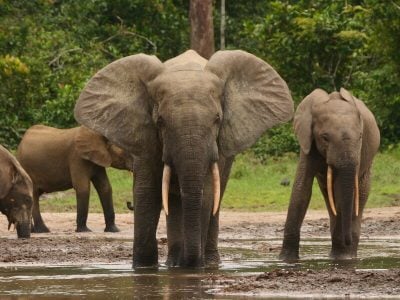
I do think that all the elphant herds need to be owned and directly managed to allow protection and sucessful economic development. No one has the best answer yet, but left as a poacher's rtarget is not ever sustainable. It is way too easy for a human with a rifle to cut one down for gain.
I also think that their range can be usefully expanded as well with human managent which can end obvious zones of conflict.
Think the Amazon in particular.
Elephants in Africa Face Grave Extinction Threat, New Expert Assessment Finds
Elephants in Africa Face Grave Extinction Threat, New Expert Assessment Finds
Africa’s Forest Elephants Recognized as Separate Species, Highlighting Peril
Global Research, March 26, 2021
Center for Biological Diversity 25 March 2021
Region: sub-Saharan Africa
Theme: Environment
https://www.globalresearch.ca/elephants-africa-face-grave-extinction-threat-new-expert-assessment-finds/5741025
In a long-awaited move, the International Union for Conservation of Nature announced today that elephants in Africa face a serious risk of extinction. At the same time, it is officially identifying African elephants as two distinct species: savanna elephants and forest elephants.
The reclassification — part of an update to IUCN’s Red List of Threatened Species — could boost recognition of the dire plight of forest elephants. Forest elephant populations were found to have declined by more than 80% in the last 93 years. Savanna elephant populations declined by more than 50% over the last 75 years.
Both forest and savanna elephants are threatened by ivory poaching and habitat loss and encroachment.
“Forest elephants are finally getting the recognition they deserve, but now we have to crack down on the poaching of these desperately imperiled animals,” said Tanya Sanerib, international legal director at the Center for Biological Diversity. “Acknowledging forest elephants as a unique species is just the first step.”
Today’s IUCN update deemed forest elephants to be critically endangered because of steep declines caused by poaching and habitat destruction. But IUCN also downgraded the status of the more prevalent savanna elephants from vulnerable to endangered.
“This is a signal to the United States and the international community that major resources must be put into curbing ivory poaching and trafficking, closing remaining domestic ivory markets, and saving these marvelous, irreplaceable engineers of the forest and savanna from extinction,” said Sanerib.
Even if poaching were halted today, forest elephants will take decades to recover because of their slow reproductive rates. Both assessments highlighted that illegally trafficked ivory has increased “substantially” since 2006, according to seizure data.
Savanna elephants (Loxodonta africana) have larger frames and ears and curving ivory tusks and are found in southern, eastern and central Africa. Forest elephants (Loxodonta cyclotis) have slightly smaller builds and ears and thinner, straighter ivory and are found in western and central Africa.
IUCN simultaneously released new assessments for 6,472 other species around the globe, and nearly a third of those species were deemed threatened with extinction. Among the species, numerous primates (monkeys, marmosets and others) were deemed endangered, as well as several fireflies, frogs (including many coqui species), turtles and sharks.
In 2019 a global assessment estimated that 1 million species worldwide face extinction if business as usual continues without transformative change. The Center’s Saving Life on Earth plan calls for $100 billion for species and habitat conservation, half the Earth to be protected for wildlife, and dramatic cuts in pollution and plastics.
No comments:
Post a Comment